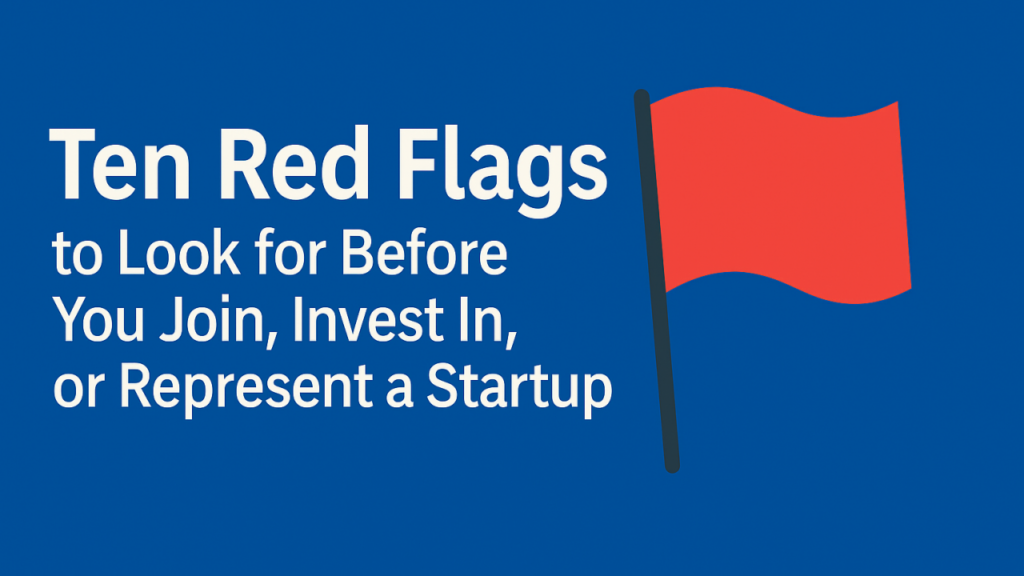
As someone who has been deep in the trenches of startup life—leading marketing transformations, advising founders, and recovering from a few spectacular crashes—I’ve learned the hard way that due diligence is not just for lawyers and VCs. Whether you’re considering joining a startup, investing in one, or taking it on as a client, these are the top ten red flags I’ve come to recognize. Ignore them at your peril. This isn’t theory. These are patterns I’ve seen play out in real time. Some I caught just in time. Others—like the stories I share in this article on two epic marketing failures—were disasters that could’ve been avoided if someone had asked the right questions sooner.
1. They Say They Have Product-Market Fit, but Can’t Prove It
If they’re claiming rapid growth or “pull from the market,” ask to see renewal rates, customer retention, or even direct references. Often, the early customer base is made up of friends and favors—not actual fit.
2. The Tech Doesn’t Work (Yet They’re Marketing It Anyway)
This one is more common than you’d like to believe. A sexy demo, a polished pitch deck, but no working product. If the “AI” is just a spreadsheet with smoke and mirrors behind it, run.
3. Funding Outpaces Traction
When the raise looks like a Series B but the customer traction looks like pre-seed, you have to wonder: is the company optimizing for PR or solving a real problem?
4. Customer Logos Without Customer Love
Beware the pitch deck adorned with Fortune 500 logos but no case
studies, no quotes, and no repeat revenue. This often signals
non-repeatable, one-off deals used to signal legitimacy.
5. Over-Polished Branding That Obscures the Truth
A beautiful website and killer pitch videos don’t mean the company is real. One of the worst frauds I saw had the best marketing materials. We found out the customer testimonials were fake.
6. Founders Who Won’t Let Go of the Narrative
If the story never changes—no matter what the data says—they’re more interested in preserving the myth than facing the reality. Dogmatic founders can burn millions chasing the wrong market.
7. No External Validation (or Fear of It)
Healthy startups encourage validation: analyst coverage, independent audits, customer interviews. If they resist external scrutiny, they may be hiding something.
8. The Culture Smells Like Chaos
Ask about turnover, especially in marketing, product, and engineering. A revolving door is often a sign of deeper dysfunction—and a management team in denial. Also, and this has affected me several times in my career, make sure there is diversity of relationships on the board and management team. Too often, I find management teams and the founder’s board made up of people with personally close relationships making it nearly impossible for “outsiders” to affect the trajectory of the company. It’s natural to have some previous relationships existing in the company, but be wary of a closed system or “cabals”.
9. Ethical Flexibility Framed as “Founder Hustle”
Be wary when bending the rules is considered a virtue. I’ve seen founders lie to investors, puff their numbers, or fake compliance “just until we close the round.” Don’t hitch your wagon to that.
10. They Want Advisors but Ignore Advice
If you’re being asked to join as an advisor, investor, or board member, but your counsel is routinely ignored, you’re a prop, not a partner. Get out before you’re blamed for the crash.
Final Thoughts
Startups are risky by design—but not all risks are worth taking. If even two or three of these red flags show up, it’s time to ask harder questions or walk away. Trust your instincts, do the work, and never confuse great storytelling for great execution. I’ve done both. One builds real companies. The other builds illusions.
🔍 Bonus: Due Diligence Checklist
Want a 1-page checklist version of this article to use in your next deal or job interview? DM me or leave a comment below, and I’ll send it to you.




